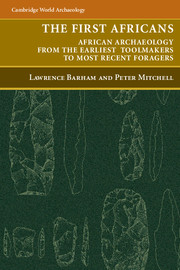Book contents
- Frontmatter
- Contents
- List of Figures and Tables
- Acknowledgements
- THE FIRST AFRICANS
- 1 Introducing the African Record
- 2 Frameworks in Space and Time
- 3 First Tool-Users and -Makers
- 4 Early Pleistocene Technologies and Societies
- 5 Mid-Pleistocene Foragers
- 6 Transitions and Origins
- 7 The Big Dry: The Archaeology of Marine Isotope Stages 4–2
- 8 Transitions: From the Pleistocene into the Holocene
- 9 Hunting, Gathering, Intensifying: The Mid-Holocene Record
- 10 Foragers in a World of Farmers
- 11 The Future of the First Africans' Past
- Notes
- Glossary
- References
- Index
2 - Frameworks in Space and Time
Published online by Cambridge University Press: 05 June 2012
- Frontmatter
- Contents
- List of Figures and Tables
- Acknowledgements
- THE FIRST AFRICANS
- 1 Introducing the African Record
- 2 Frameworks in Space and Time
- 3 First Tool-Users and -Makers
- 4 Early Pleistocene Technologies and Societies
- 5 Mid-Pleistocene Foragers
- 6 Transitions and Origins
- 7 The Big Dry: The Archaeology of Marine Isotope Stages 4–2
- 8 Transitions: From the Pleistocene into the Holocene
- 9 Hunting, Gathering, Intensifying: The Mid-Holocene Record
- 10 Foragers in a World of Farmers
- 11 The Future of the First Africans' Past
- Notes
- Glossary
- References
- Index
Summary
Any account of the past needs a set of guidelines if it is to be understandable. This chapter sketches some of the essential frameworks for our history of the first Africans. We begin with a short survey of Africa's geography as it is today. Following this, we look at the key changes that have taken place in African environments and climate over the past several million years and how it is that we know about them. As we have already remarked, the global sequence of oxygen isotope stages is crucial for understanding these changes and also provides the chronological structure for our narrative. Having discussed palaeoenvironmental change in more detail, we conclude this chapter by considering how we can date the past.
INTRODUCING AFRICA
Physical Geography
Africa is among the world's oldest landmasses, having taken on its basic geographical form as the Gondwanaland supercontinent, which broke up 200–100 mya (Fig. 2.1). Surrounded by water on almost all sides (save for the narrow Sinai landbridge to southwestern Asia), Africa currently straddles the Equator to almost equal extents, reaching 36°N and 35°S. Its northern part is, however, substantially larger and more extensive from east-to-west. Because much of the continent consists of shallow basins or plateaux separated by scarcely evident watersheds, topography has relatively little effect on climatic zones and biomes. Important exceptions to this generalisation in the south include the Great Escarpment, which reaches altitudes of 3000 m above sea level in places, and the Cape Fold Mountain Belt.
- Type
- Chapter
- Information
- The First AfricansAfrican Archaeology from the Earliest Toolmakers to Most Recent Foragers, pp. 29 - 58Publisher: Cambridge University PressPrint publication year: 2008



